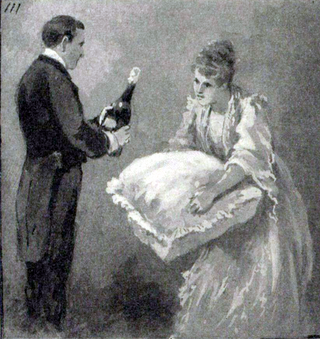
Sir Arthur Wing Pinero was an English playwright and, early in his career, actor.

The Second Mrs. Tanqueray is a problem play by Arthur Wing Pinero. It utilises the "Woman with a past" plot, popular in nineteenth century melodrama. The play was first produced in 1893 by the actor-manager George Alexander and despite causing some shock to his audiences by its scandalous subject it was a box-office success, and was revived in London and New York in many productions during the 20th century.

Man and Superman is a four-act drama written by George Bernard Shaw in 1903, in response to a call for Shaw to write a play based on the Don Juan theme. Man and Superman opened at the Royal Court Theatre in London on 21 May 1905 as a four-act play produced by the Stage Society, and then by John Eugene Vedrenne and Harley Granville-Barker on 23 May, without Act III. A part of the third act, Don Juan in Hell, was performed when the drama was staged on 4 June 1907 at the Royal Court. The play was not performed in its entirety until 1915, when the Travelling Repertory Company played it at the Lyceum Theatre, Edinburgh.

Thomas William Robertson was an English dramatist and stage director known for his development of naturalism in British theatre.
Trelawny or Trelawney may refer to:

John William Francis Hallam was a British character actor, who frequently played hard men or military types.

The Garrick Theatre is a West End theatre, located in Charing Cross Road, in the City of Westminster, named after the stage actor David Garrick. It opened in 1889 with The Profligate, a play by Arthur Wing Pinero, and another Pinero play, The Notorious Mrs. Ebbsmith, was an early success at the theatre. In its early years, the Garrick appears to have specialised in the performance of melodrama. The theatre later became associated with comedies, including No Sex Please, We're British, which played for four years from 1982 to 1986.

Mary Mannering was an English actress. She studied for the stage under Hermann Vezin. She made her debut at Manchester in 1892 under her own name of Florence Friend.

Dame Irene Boucicault DBE, née Barnes, known professionally as Irene Vanbrugh was an English actress. The daughter of a clergyman, Vanbrugh followed her elder sister Violet into the theatrical profession and sustained a career for more than 50 years.
Charlotte Cornwell was an English actress, singer, and a teacher of acting on the faculty at the University of Southern California (2003-2012).

Amelia Swilley Bingham was an American actress from Hicksville, Ohio. Her Broadway career extended from 1896 until 1926.
George Rowell was a British theatre historian, lecturer and authority on the 19th century. His specialisms included Victorian melodrama and the theatre of Henry Irving, W. S. Gilbert, Oscar Wilde and Arthur Wing Pinero.

Oliver Peters Heggie, billed as O. P. Heggie, was an Australian film and theatre actor best known for portraying the hermit who befriends the Monster in the film Bride of Frankenstein (1935). He was born Otto Peters Heggie at Angaston, South Australia to a local pastoralist. He was educated at Whinham College and the Adelaide Conservatoire of Music. He died in Los Angeles of pneumonia. He is buried at Woodside Cemetery, Yarmouth Port, Barnstable County, Massachusetts.

Dandy Dick is a three-act farce by Arthur Wing Pinero, first performed in London in 1887. It depicts the complications arising when a respectable clergyman is persuaded to bet on a horse race to subsidise building works on his church. The play has been revived several times and has been adapted for the cinema, radio and television.

The Actress is a lost 1928 American silent drama film produced and distributed by Metro-Goldwyn-Mayer. The film was directed by Sidney Franklin, and starred Norma Shearer.
Trelawny of the Wells is a 1916 British silent romance film directed by Cecil Hepworth, and starring Alma Taylor, Stewart Rome, and Violet Hopson. It is an adaptation of the 1898 play Trelawny of the Wells by Arthur Wing Pinero. The story was later filmed as a late silent by MGM in 1928 under the title The Actress, starring Norma Shearer.

The Gay Lord Quex is an 1899 comedy play by the British playwright Arthur Wing Pinero. It depicts the vicissitudes of a reformed philanderer attempting to embark on monogamy. The original production provoked controversy, some critics finding the plot at best questionable and at worst immoral.

Mace Greenleaf was an American stage and silent film actor.

The Lyceum Theatre was a theatre in New York City located on Fourth Avenue between 23rd and 24th Streets in Manhattan. It was built in 1885 and operated until 1902, when it was torn down to make way for the Metropolitan Life Insurance Company Tower. It was replaced by a new Lyceum Theatre on 45th Street. For all but its first two seasons, the theatre was home to Daniel Frohman's Lyceum Theatre Stock Company, which presented many important plays and actors of the day.

Ada Ferrar was a British actress of the late Victorian and Edwardian eras.

















